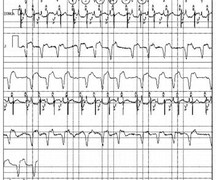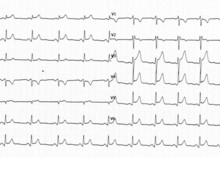SecureSense™ algorithm and T waves oversensing during spontaneous ventricular rhythm
Tracing
Manufacturer Abbott
Device ICD
Field Securesence
N° 7
Patient
This 69-year-old man presenting with an ischemic cardiomyopathy received a Abbott Ellipse™ DR dual chamber defibrillator for a primary prevention indication. Episodes of non-sustained ventricular oversensing were recorded in the memories. Two zones of detection were programmed, including VF at 222 bpm (270 ms cycle length) and VT at 171 bpm (350 ms cycle length). The SecureSense™ algorithm was programmed ON (between the RV coil and the can).

Graph and trace
- sinus rhythm; the presence of VS2 markers on the discrimination channel, in the beginning of tracing, indicates that the noise counter is activated;
- T-wave oversensing (post R wave) limited to the bipolar channel (no VS2 marker in the discrimination channel);
- short cycles on the bipolar channel (-) corresponding to the next QRS complex (short TR interval); absence of short cycles on the discrimination channel; the noise counter increases by +1;
- further T wave oversensing on the bipolar channel;
- short cycles are present on the bipolar though not on the discrimination channel;
- T wave oversensing on the bipolar channel with 2 markers for each cycle, in contrast with a single VS² marker for each cycle on the discrimination channel;
- the noise counter is at 10 whereas the VF or VT counter is not filled; diagnosis of non-sustained ventricular oversensing (SNS).
Other articles that may be of interest to you
EGM recordings






T-wave oversensing during spontaneous ventricular rhythm remains a serious problem of management of ICD recipients. It may be the cause of inappropriate therapies, particularly during exercise, when the RT and TR intervals are consistent with the VF zone. T wave oversensing is associated with a typical aspect of alternans between 2 morphologically different signals: a high frequency signal (R wave) and a low frequency signal (T wave). With each cardiac cycle, the device counts an R and a T wave, this second signal doubling of the heart rate.
T wave oversensing after a spontaneous ventricular event occurs preferentially, as in this example, in presence of low-amplitude R waves. Both the sensitivity and the gain are automatically adjusted to the amplitude of the sensed R wave. When the R wave amplitude is low, the device reaches rapidly high sensitivity levels, which facilitates oversensing of the T wave. The Saint Jude Medical devices allow the programming of specific settings to conceal and prevent the detection of T waves, including ventricular sensitivity, threshold start, decay delay and ventricular filters. The reprogramming choices are limited, however, when the main problem is a low-amplitude R wave.
The SecureSense™ algorithm was initially conceived to prevent the delivery of inappropriate therapies due to lead rupture. It also represents a major progress in the management of T wave oversensing. To trigger the delivery of inappropriate therapy, oversensing must occur nearly simultaneously on the bipolar and on the discrimination channels. The presence of the very precise conditions causing T wave oversensing (low-amplitude R wave, low R/T ratio, unfiltered T wave) at the same time on both channels is improbable. In this example, the T wave is oversensed on the bipolar channel only when the preceding R wave amplitude is low. On the other hand, the amplitude of the R wave on the discrimination channel is visibly much taller, explaining the absence of oversensing on this channel. Therefore, the noise counter increases with each short cycle on the bipolar channel without being reset to 0. Even if the VF counter had been filled, the therapies had been inhibited, since the count on the noise counter exceeded 10.
This tracing also shows that this algorithm allows a rapid diagnosis, including when oversensing is intermittent. Without the programming of the SecureSense™ algorithm, oversensing observed on this tracing would have remained unnoticed. In practice, programming of this algorithm lowers considerably the delivery of inappropriate shocks due to T wave oversensing.